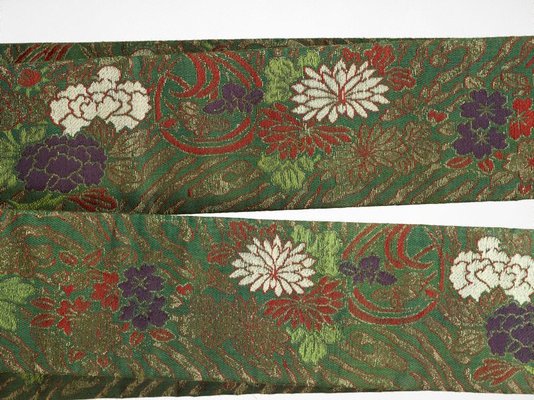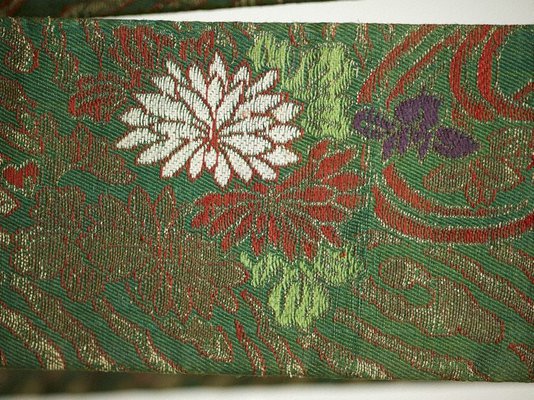



-
Details
- Place where the work was made
-
Japan
- Period
- Edo (Tokugawa) period 1615 - 1868 → Japan
- Date
- 1750-1850
- Media category
- Textile
- Materials used
- silk twill-weave, coloured silk and gold threads supplementary weft patterning
- Dimensions
- 362.0 x 9.0 cm
- Credit
- Purchased with funds provided by the Asian Art Collection Benefactors 2014
- Location
- Not on display
- Accession number
- 239.2014
- Copyright
- Share
-
-
About
'Koshimaki obi', also called 'tsuke obi', is a narrow sash made of brocade. When in use, it is stiffened with straw to create a tubular shape. The obi is wrapped around the waist (hence koshi = waist; maki = to wrap) to secure the 'koshimaki', a type of kosode made of silk, dyed in dark tone, embellished with embroidered small, repetitive pattern and worn as an outer garment tied at the waist with the upper part draping from the waist line. The 'koshimaki obi' was introduced in the 18th century as a special type of sash, used specifically to support the 'koshimaki' outer garment and to extend its sleeves on either side of the body. 'Koshimaki' was worn by women of the elite samurai class over a 'katabira' as formal summer attire. By the late Edo period, 'koshimaki' became the formulaic clothing for female attendants in daimyo and shogunal households.
This obi is decorated with floral motifs representing the four seasons: cherry blossoms indicate spring, narcissus and peonies symbolise summer and chrysanthemums stand for autumn. Beautifully scattered on undulating lines suggesting stylised ripples on a water surface, the flowers and water are achieved through supplementary weft of coloured silk and gold threads set against green twill weave ground. There are only few Edo period 'koshimaki obi' extant today, and this sash is in a very good condition, with a few minor abrasions at both ends.
REFERENCES:
Gluckman, Dale Carolyn & Takeda, Sharon Sadako. 'When art became fashion : kosode in Edo-period Japan'. With contributions by Monica Bethe, Hollis Goodall-Cristante, William B. Hauser, Kirihata Ken, Maruyama Nobuhiko, Nagasaki Iwao, Robert T. Singer. New York/Tokyo: Weatherhill and Los Angeles County Museum of Art, 1992Stinchecum, Amanda Myer. 'Kosode, 16th-19th century textiles from the Nomura Collection'. With essays by Monica Bethe and Margot Paul ; edited by Naomi Noble Richard and Margot Paul, New York: Japan Society and Kodansha International, 1984.
Asian Art Department, AGNSW, 2014.
-
Places
Where the work was made
Japan
-
Exhibition history
Shown in 1 exhibition
Conversations through the Asian collections, Art Gallery of New South Wales, Sydney, 25 Oct 2014–13 Mar 2016
